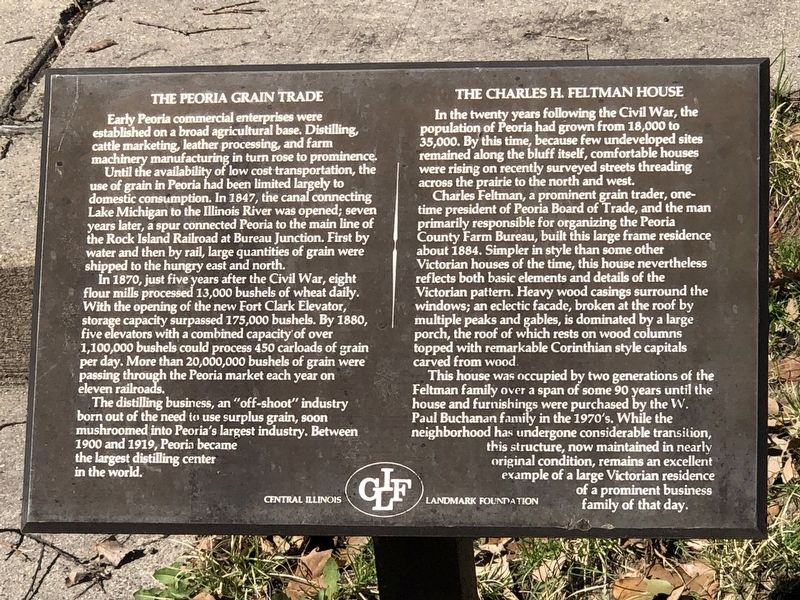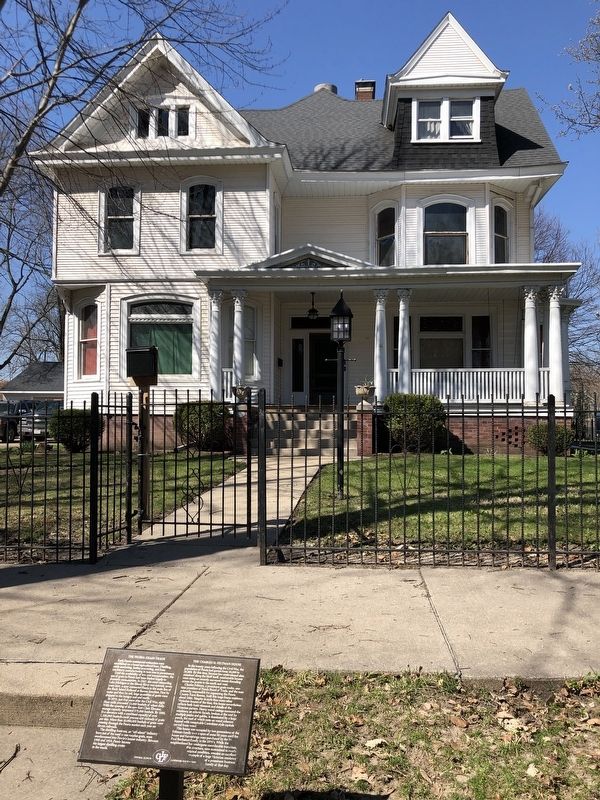Peoria in Peoria County, Illinois — The American Midwest (Great Lakes)
The Peoria Grain Trade / The Charles H. Feltman House
Inscription.
The Peoria Grain Trade Early Peoria commercial enterprises were
established on a broad agricultural base. Distilling,
cattle marketing, leather processing, and farm
machinery manufacturing in turn rose to prominence.
Until the availability of low cost transportation, the use of grain in Peoria had been limited largely to domestic consumption. In 1847, the canal connecting Lake Michigan to the Illinois River was opened; seven years later, a spur connected Peoria to the main line of the Rock Island Railroad at Bureau Junction. First by water and then by rail, large quantities of grain were shipped to the hungry east and north.
In 1870, just five years after the Civil War, eight flour mills processed 13,000 bushels of wheat daily. With the opening of the new Fort Clark Elevator, storage capacity surpassed 175,000 bushels. By 1880, five elevators with a combined capacity of over 1,100,000 bushels could process 450 carloads of grain per day. More than 20,000,000 bushels of grain were passing through the Peoria market each year on eleven railroads.
The distilling business, an “off-shoot” industry born out of the need to use surplus grain, soon mushroomed into Peoria's largest industry. Between 1900 and 1919, Peoria became the largest distilling center in the world.
The Charles H. Feltman House In the twenty years following the Civil War, the population of Peoria had grown from 18,000 to 35,000. By this time, because few undeveloped sites remained along the bluff itself, comfortable houses were rising on recently surveyed streets threading across the prairie to the north and west.
Charles Feltman, a prominent grain trader, one- time president of Peoria Board of Trade, and the man primarily responsible for organizing the Peoria County Farm Bureau, built this large frame residence about 1884. Simpler in style than some other Victorian houses of the time, this house nevertheless reflects both basic elements and details of the Victorian pattern. Heavy wood casings surround the windows; an eclectic facade, broken at the roof by multiple peaks and gables, is dominated by a large porch, the roof of which rests on wood columns topped with remarkable Corinthian style capitals carved from wood.
This house was occupied by two generations of the Feltman family over a span of some 90 years until the house and furnishings were purchased by the W. Paul Buchanan family in the 1970's. While the neighborhood has undergone considerable transition, this structure, now maintained in nearly original condition, remains an excellent example of a large Victorian residence of a prominent business family of that day.
Erected by
Central Illinois Landmark Foundation.
Topics. This historical marker is listed in these topic lists: Agriculture • Architecture • Industry & Commerce. A significant historical year for this entry is 1847.
Location. 40° 42.268′ N, 89° 35.945′ W. Marker is in Peoria, Illinois, in Peoria County. Marker is at the intersection of West Armstrong Avenue and North North Street, on the right when traveling west on West Armstrong Avenue. Touch for map. Marker is at or near this postal address: 401 W Armstrong Ave, Peoria IL 61604, United States of America. Touch for directions.
Other nearby markers. At least 8 other markers are within walking distance of this marker. Armstrong Homestead (about 400 feet away, measured in a direct line); Pulsifer's Grove/John C. Wynd Residence (approx. 0.2 miles away); The Gipps Brewing Co./The Ballance-Herschel House (approx. 0.2 miles away); Julia Ballance House/Roanoke-Randolph Historic District (approx. 0.2 miles away); Peoria's Historic Brick Boulevard (approx. ¼ mile away); Sentinel on the Bluff (approx. 0.4 miles away); The Easton Fountain (approx. 0.4 miles away); Erastus D. Hardin House (approx. half a mile away). Touch for a list and map of all markers in Peoria.
Credits. This page was last revised on April 11, 2023. It was originally submitted on April 11, 2023, by Duane and Tracy Marsteller of Murfreesboro, Tennessee. This page has been viewed 95 times since then and 24 times this year. Photos: 1, 2. submitted on April 11, 2023, by Duane and Tracy Marsteller of Murfreesboro, Tennessee.

